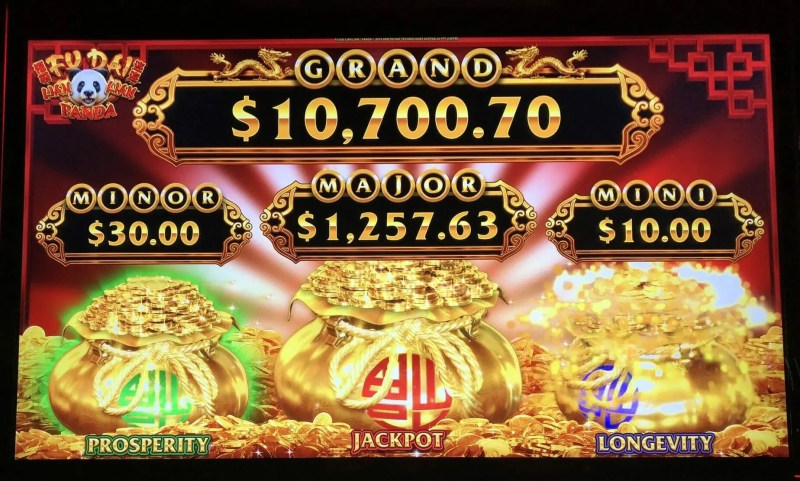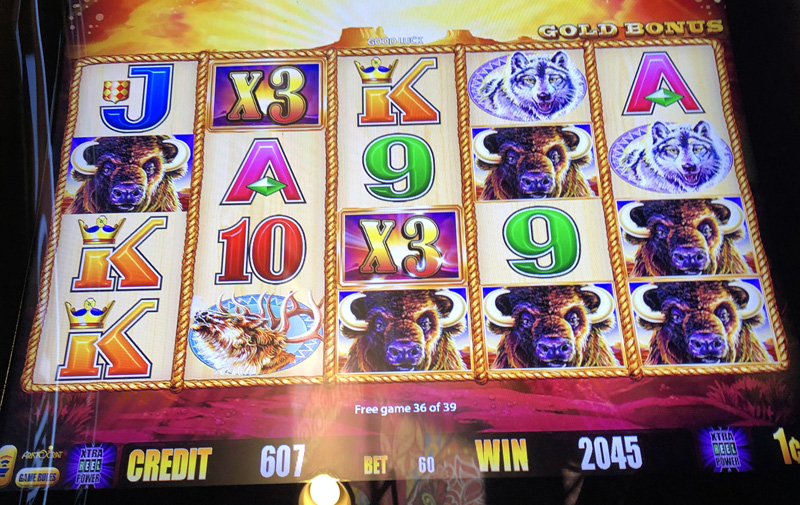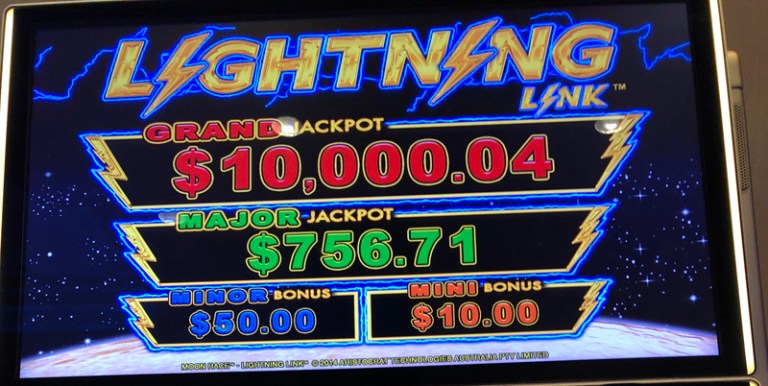by Josh O’Connell
Slot machines have a lot of components to them. When you read about them, or people talking about them, you may hear terms relating to them and wonder what they are.
In this article you’ll find a variety of terms related to a slot machine, and a sense of why they’re important to be a part of the game or machine.
Accumulator
In slot industry speak, those various graphics on a slot machine that shows a progression, such as a pot filling, a bag growing, or fireworks slowly lighting up over time as you spin, is called an accumulator.

The “accumulators” show the amount of coins growing in each bag.
Most of the time they don’t do anything but show how long in relative terms it’s been since a feature occurred; they usually don’t indicate one is on the way or due to hit.
All Ways Pays
On a game where all ways pays, there are not a set number of paylines (see the definition below) but instead pays as long as symbols appear on successive reels at least once. Sometimes these symbols can be stacked, or clumped, yielding larger wins.

All ways pays in action on a Buffalo slot machine.
A great example of this concept in action is Buffalo, where you can often times see 2 or 3 Buffalo symbols on a reel, boosting the overall payout because you’re paid for each individual combination of buffalos.
Anticipation or Suspense Spin
A game may tease out the potential for a bonus or big win by doing something to build anticipation or suspense. Examples of this would be the reels spinning longer after you have landed two bonus symbols, building suspense for a potential third spin, or showing an animation before a big win or bonus to effectively build the anticipation for such a good scenario happening.
Candle
Most slot machines have two lights at the top of the machine, which is known as a candle.

The slot machine “candle” can be seen at the top of each of these slots.
The candle was a very helpful tool in the days before modern technology to tell a slot tech if a game hit a jackpot, had recently been opened or was having an issue, among various indicators. One light could also be tinted to indicate the lowest denomination a particular game offers.
Cascading / Tumbling Reels
This is a more unique type of game where when you have a winning combination on a spin, after you’re paid for that combination, those symbols disappear, and more drop down. If you have a winning combination at that point, you’re paid again, and they disappear, dropping down even more. These games take advantage of modern virtual reel capabilities, something that couldn’t be done in the days of mechanical reels.
Credits
Slots will often display how much money is in the machine, but how many credits you have. Credits are simply the amount of money you have, divided by the denomination of the game you are currently playing. This shows effectively how many betting units you have to work with.
Dead Spin
A dead spin is a term for a slot machine spin where you don’t win anything. Some games are designed to produce more dead spins than others, and can be a way to tell how easy or tough a game is (see Hit Rate, below, for more on this).
Denomination
A game’s denomination is how much each credit is worth. Most slot machines start with a penny denomination, so each credit is worth a penny, but a denomination can go all the way up into the hundreds of dollars per credit.
Most lower denomination games require more credits to be wagered to play all the lines and/or bonuses, whereas often times higher denomination games require less lines or credits to qualify for everything.
False Win
With games having more lines than they used to, a false win is when you get paid something for a spin, but it’s less than your bet. For example, if you play a 20 line slot with a total bet of $1, and you get 5 lines each paying 10 cents, you won 50 cents but it’s less than your $1 bet. False wins can still play win music and have other traits of a winning spin, even though you didn’t win enough to recover your bet.
Free Pick or True Pick
In this form of a bonus, what you pick is truly what you picked – the game is set up with an array of options and your picks have an impact on the bonus. A great example of these are the Jackpot Party series of games.

The Village People Party pick’em bonus round is an example of a true pick’em bonus.
Most of the time, if it reveals the unpicked options, the bonus is a true pick, but there are examples of Everi games where the scripted bonus does reveal the other options. So in the case of that game maker specifically, if it reveals it, it’s not guaranteed that it’s a free pick.
Hit Rate
A hit rate determines how often a game will deliver some sort of a payout. Games with higher hit rates tend to pay smaller amounts for each win and are as such games with lower volatility. Games with lower hit rates will often pay bigger amounts when they do pay, and are as such games with higher volatility.
(Bonus definition: Volatility is effectively a term for how easy or tough a game will be. Put simply, lower volatility games pay less for each win, but offer winning spins more often; higher volatility games pay more for each win, but offer winning spins less often.)
Hot & Cold Slots; Loose & Tight Slots
All four terms are used to describe when a slot has been paying, or when it has not been paying. None of these descriptions will help you know what will happen next. Some players will suggest to leave a cold slot or keep playing a hot slot, but it only describes the past, and any outcome is possible with each press of the button.
Mechanical and Virtual Reels
Mechanical reel slots are those that have physical reels that spin around in a machine. Those were the dominant form of slots before the computer age brought in more modern machinery that allowed for what are now virtual reels, which are those generated by a computer.

Three mechanical reels on a slot machine.
Under the hood both types can and often do work similarly; virtual reels can benefit from having no physical limitation for how many symbols can fit on a reel, so they allow for more complex or unique slot designs.
Payback vs. House Edge
A slot machine’s payback is how much, over the course of time, a game is expected to payback. Conversely, the house edge is how much a casino will over time keep for itself. For instance, if a game pays out 90 percent over time, the casino house edge on that same game will be 10 percent over that same time (the two percentages will add to 100 percent).
Paylines
One way a slot machine can determine what constitutes a winning spin is to have an array of paylines, and if the right symbols align on a payline, you’re paid based on what that combination pays.
Paylines mean that there could be combinations that don’t pay because it’s not on a payline, and sometimes players can choose to play less paylines than the game offers.
Poker Symbols and Premium Symbols
Most slot machines use familiar symbols to help you know what pays best and what pays worst. Oftentimes poker symbols, such as Ace, King, Queen and Jack (and more frequently nowadays 10, 9 or even 8!) are used to convey that these are the lower paying symbols. Premium symbols tend to fill more of the space on the reel (the more space it fills, the more likely it’s a big payer or a bonus symbol).
These visual cues are designed to help players get comfortable with a new game more quickly, by using design cues that are consistent across various slots.
Progressives
A progressive is a prize that grows as players either make wagers (in most cases) or have winning spins (in a few cases).

Lightning Link is an example of a slot machine with progressive jackpots.
Progressives can be individual to a machine, linked to a group of machines or even being linked across a group of casinos in the case of wide-area progressives. Usually the bigger the progressive is, the more likely the progressive is either linked or part of a wide-area progressive.
Random Number Generator
Vegas-style slots use the concept of a Random Number Generator to cycle through the various combinations possible to ensure that any outcome could be possible on any spin. Technically it’s not truly random, as it was a system developed by humans, but it’s sufficiently random to serve the purpose of ensuring a slot’s outcomes are equally possible mathematically over time.
Reel Set / Board
A reel set, or board, is the set of reels that work together to make up a single game on a slot machine. Old school mechanical reels generally have three or five reels; most virtual reel games have five reels. Games like Wonder 4, Power 4 or Reel Boost have four reel sets or boards on them during a regular spin, and there are games that can have even more!
Reel Stop
A reel stop is a single position on a slot reel where it can come to a stop. The number of reel stops can be a way to determine how many outcomes there are; in other cases reels can be weighted (see definition below) to favor some stops over others.
Scripted or Predetermined Bonus
A scripted bonus, also known as a predetermined bonus, is one where the outcome is already determined before the bonus is completed. This can be a picking bonus where the symbols that appear with each pick are already known, or a free spins bonus where the final win is already determined and the spins simply occur that add up to that value.
If the unpicked options don’t reveal themselves, you can figure it’s a scripted or predetermined bonus.
Ticket In/Ticket Out (TITO)
Slot machines shifted from dispensing primarily coins to dispensing tickets around the turn of the century; the system that allows for tickets to be both inserted and printed is called a TITO system. Many players nowadays refer to the ticket itself as a TITO as well. The shift to tickets has allowed for modern low denomination slot machines to exist in a much larger form, since games don’t need to be loaded with pennies or nickels.
Weighted Reels
When you see a slot machine with mechanical reels, one might presume that the frequency the symbols appear on the reels is how often a given symbol could appear. However, slot manufacturers use the concept of weighted reels to have some stops occur more often than others. By doing this, they can have a set of reels that can have many more outcomes than if each stop had an equal chance of happening. (A side effect of this is they can make the top jackpot bigger, as it can be harder to hit accordingly.)
A similar concept exists for wheels, such as atop Wheel of Fortune games – while there’s only a certain number of positions on the wheel, the lower amounts have much higher chances of hitting vs. the top prize than is implied by the layout of the wheel – in this case it’s a weighted wheel, vs. a weighted reel, but the same concept applies.
Conclusion
Now you know many of the terms for what makes your slot machine run so smoothly! The next time you visit a casino, I bet you’ll notice a few more things about slots than you did before reading this article.
Joshua O’Connell is the author of Know Your Slots, a casino website that talks about slot machines and how they work,
comps, travel, cruises and other casino-related topics. New and updated content is posted daily.
